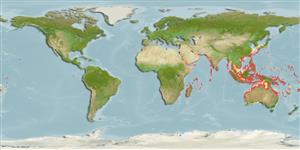Common names from other countries
Environment: milieu / climate zone / depth range / distribution range
Sinh thái học
; Mức độ sâu 1 - 50 m (Ref. 4), usually 1 - 8 m (Ref. 4). Tropical; 45°N - 37°S, 30°E - 171°W (Ref. 4)
Indo-West Pacific.
Length at first maturity / Bộ gần gũi / Khối lượng (Trọng lượng) / Age
Maturity: Lm ?, range 4 - 7.86 cm Max length : 50.0 cm TL con đực/không giới tính; (Ref. 4); common length : 35.0 cm TL con đực/không giới tính; (Ref. 4)
It has a maximum total body length of 50 cm, but usually much smaller (30 to 35 cm) (Ref. 4). It is found in shallow, sometimes slightly turbid coastal waters, from 1 to 8 m depth, with a record of 50 m deep. It inhabits sandy and muddy substrates, sometimes on rocky bottoms, often near the mouth of rivers, but also on coral reefs (Ref. 4). Subtidal (Ref. 106854). Juveniles occur in holes and crevices which are partially covered by seagrass or macroalgae (Ref. 106919). It is solitary, may live in pairs and has been found in larger concentrations (Ref. 4). Omnivore (Ref. 116259).
Members of the order Decapoda are mostly gonochoric. Mating behavior: Precopulatory courtship ritual is common (through olfactory and tactile cues); usually indirect sperm transfer.
Holthuis, L.B. 1991. (Ref. 4)
IUCN Red List Status (Ref. 130435)
CITES status (Ref. 108899)
Not Evaluated
Not Evaluated
Human uses
Các nghề cá: Tính thương mại
| FishSource | Biển chung quanh ta
Các công cụ
Các nguồn internet
Estimates based on models
Preferred temperature
(Ref.
115969): 24.6 - 29.3, mean 28.4 (based on 3578 cells).
Thích nghi nhanh
Chiêù cao, thời gian nhân đôi của chủng quần tối thiểu là dưới 15 tháng (K=0.57).
Vulnerability
Moderate vulnerability (40 of 100).
